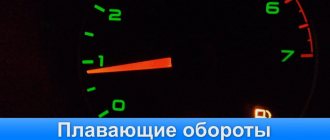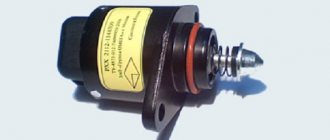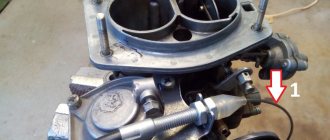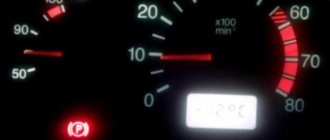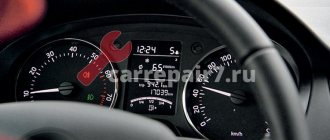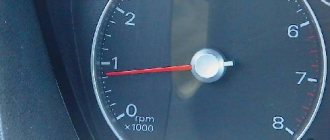After warming up the car, error 2115: rich mixture and with a sharp release of gas, a deep drop in speed.
- The idle speed does not drop, Samara 2 – 2 answers
- Error code 0340 in VAZ 2115 – 4 answers
- Dips at idle, VAZ 2115 – 4 answers
- The VAZ 2115 check light is constantly on - 4 answers
- Error on the instrument panel of VAZ 2114 - 3 answers
And the throttle assembly in the sink.
I wrote to you about the throttle position sensor, and not about what you listed. And bad gasoline also cannot be ruled out, but your engine runs smoothly and there are no jerks during acceleration or is that not so? A week ago I changed the air flow sensor with the same symptoms. But at first there were failures, after replacement a rich mixture was added to the failures (the Volt sensor was available), I installed the old one again, went and bought a new one and replaced it. I'm enjoying it.
Subscribe
to our channel in
Index.Zen
Even more useful tips in a convenient format
The idle speed does not drop, Samara 2
If, with a sharp release of gas, the engine speed drops to 400-500 rpm, then most likely the system simply does not have enough air due to a small leakage through the idle speed regulator. In order to get rid of the drop in speed on engines with a mechanical throttle, you need to tighten the throttle adjusting screw. On VAZ cars this screw is marked under the letter “B” and is usually painted over from the factory:
To fix the problem, it is necessary that the throttle valve be opened a little more when the gas pedal is not pressed. To do this, the screw should be turned clockwise. Using the method of test runs of the engine, determine the optimal position of this screw until the dips go away.
Does the car stall when you let off the gas? List of possible problems
Surely every car owner has experienced such an unpleasant situation when the car stalls when releasing the gas.
This problem is one of several most common. To begin with, I would like to clarify why the engine may be plugged during a reset. The very first and most common problem is the banal clogging of the gap in the throttle valve. Another equally popular problem is the dying of the regulator, and they can break quite often. It’s not uncommon to hear from people that it got to the point where they had to completely change it. Or some people benefit from a very serious and deep flush.
Dips and uneven engine operation on the VAZ-2114
#1 St4n
Garage workers
2531 messages
Yesterday my combat VAZ decided to scare me - when driving around the city, the engine suddenly began to run unevenly. It was idling, when you pressed the gas, the vibration intensified, the car drove very poorly, did not pull, when you pressed the gas pedal, it first “failed”, and then barely drove, sneezing and farting. Moreover, the vibrations gradually became stronger, and the engine worked worse and worse - when I stopped at a traffic light, the car was already pounding, and the sound of the engine was similar to the “droning” of a Subaru Impreza.
At a traffic light, I turned off the engine and started it again - it got better, the engine started working more equally, but over time it also slowly gave out. I reached the parking lot and opened the hood - checked the level and condition of the oil, pulled the high-voltage wires - everything seemed to be normal. Five minutes later I started the car - it works fine, pulls normally, drives as if nothing had happened. I calmly went about my business, and then drove home - with the throttle evenly open (60 km/h), the car twitched a couple of times, as if there was something wrong with the fuel supply. However, I got home fine.
I started it this morning and it works great again, as if nothing had happened. I calmly drove to the auto shop (12 km) and back, without a hint of uneven operation (but subjectively, when you press the gas pedal sharply, you seem to feel a slight dip before picking up speed).
I also remembered that some time ago (a month, maybe) it happened a couple of times that the car would stall when releasing the gas and pressing the clutch (when approaching an intersection or crossing). It stalled - I started it with half a kick, then it drove normally, I forgot about it and gave up.
I think that the problem is somewhere in the throttle assembly - IAC, MAF, TPS, I will check first (although it turns out that the nodes seem to work, only periodically giving out malfunctions).
The car is 2008, mileage 82 thousand kilometers, engine from Kalina 1.6 with 8 bugs.
What else could be the reason? I ask for advice, share your experience.
Problems and their solutions
The car stalls when you let off the gas - but what exactly lies behind this problem? Everything is quite simple, after reaching a certain speed, the foot is removed from the gas pedal and the car simply stalls. With all this, when the ignition is applied and at idle, everything works more than with a bang.
Despite the advice given above, the problem may not be solved, since they are general preventive measures for a stalled engine. As for the problem itself, it’s worth paying attention to several sensors.
Causes of failures when pressing the gas pedal
Let's look at the main reasons:
- Spark plugs and high-voltage wires;
- Clogged fuel injectors;
- The throttle valve is dirty;
- The ignition is set incorrectly;
- Errors in the ECU;
- The air filter is clogged;
- Problems with the fuel pump.
Often, failures occur due to a breakdown of the power system. After pressing the gas pedal, the power system increases the volume of fuel supplied to the cylinders. Breakage causes a change in these proportions. Those. The motor just can't do its job.
In addition, it is possible that there may be a breakdown in the ignition system. It occurs much less frequently. It's either spark plugs or ignition wires. The spark plugs must be removed and checked. The presence of carbon deposits or too clean spark plugs indicate a rich or lean fuel mixture, respectively. This indicates that the ignition system is adjusted incorrectly.
Dips when pressing the gas pedal during acceleration
It is determined both using computer diagnostics and by the steps described below (some of the points below can be performed independently, but specialists in car services in Moscow will be able to determine the problem area more quickly and accurately):
- The first thing you need to do is inspect the spark plugs. To do this you need to remove them. The presence of carbon deposits on the spark plugs, poor contact with the wires, or an excessively lean or rich mixture lead to spark plug malfunctions.
- High voltage wires can also cause engine malfunction, as can ignition coils.
- The throttle needs to be checked. If it is clogged, this causes the engine to respond untimely when pressing the gas pedal.
- It is necessary to check the condition of the air, fuel and oil filters. They tend to get clogged, which worsens dynamics, increases fuel consumption and causes pedal failure. They need to be changed constantly, you can do it yourself, they are inexpensive and easy to install.
- The presence of errors in the ECU leads to failures.
- Clogged injectors. If necessary, replace or repair injectors.
The wires, as well as the rubber bands on them, should not be damaged and should not spark when the engine is running. If damage is found, this indicates that the engine is shaking and jerking begins. This may occur due to the age of the car, worn-out or low-quality spare parts, poor contact with the spark plugs, or due to the temperature of the engine.
The resistance of the coils and the temperature change together, as a result of which a gasoline car begins to jerk during acceleration. In diesel cars, jerking cannot be associated with the coils, since they are not present.
Dips when pressing the gas pedal at idle
Problems also occur at idle speed; of course, there will be fewer reasons. However, this is also a serious problem and cannot be ignored, because... The car will have difficulty starting and simply stall.
Troubleshooting is performed in the following order:
- The first thing to check is the spark plugs. If the spark plugs are faulty, they should be replaced. We recommend replacing all spark plugs at the same time. Buy spark plugs specifically for your engine. If necessary, adjust the gap; it should be 1 mm for 92 gasoline.
- The fuel filter and fuel pump diagnostics are checked. If a malfunction is identified, fix it.
- The breakdown may be in the idle speed sensor.
- Checking the injectors. If clogged, replacement or cleaning is necessary.
- Diagnostics of the ECU for errors.
- Checking the injector.
Sensors
The first of them is the idle speed sensor. This device is located in the engine control system. It is used in cars to stabilize idle speed. Its abrupt performance often precedes the engine turning off when the gas pedal is released. If this is exactly the sequence, then with a 90% probability this particular sensor is involved and you need to start digging in its direction.
As you can understand, this sensor is designed to supply air to the engine to maintain normal idle speed. This sensor is a very important component of the entire fuel supply system to the engine, and it works closely with the injection system.
Second
– this is an air flow sensor, it is located in the same system as the previous one, only it works more globally and is responsible for a greater number of operations.
TPDZ
Another likely sign is TPS. This is especially true if your car is equipped with so-called “e-gas”. This technology has been used in cars since 2010. When the throttle is fully computer controlled, the influence of TPS on machine performance increases.
A faulty DPS may incorrectly regulate the supply of the fuel mixture, as a result of which the mixture becomes excessively lean or, conversely, excessively rich. Neither option contributes to stable engine operation.
Purpose of the pxx controller
We consider this problem to be less likely because it is almost always associated with a Check Engine Light. And since you didn't include it in your list of symptoms, it may not exist. Therefore, it is recommended to start testing this case after abandoning the first two options.
Information on how to check TPS can also be obtained from us.
We wish you good luck in repairing your car!
Other reasons and their solutions
Another reason may be the wedge of the XX valve. This problem can be temporarily solved by simply tightening the throttle cable a little. Then see what happens. The notorious XX sensor can also be involved here. It also contains more than a dozen problems, but most of them can be solved by simple washing.
It is the sensor that is washed
, or to be more precise, its components in the form of a needle and its hole where it enters. Checking its functionality is quite simple, you need to remove the sensor itself, activate the connector, then disconnect the battery for a short period of time, then connect it again and turn on the ignition, you will see how the needle begins to make forward-return movements.
Another reason could be the battery terminal. In order for everything to be in order, it needs to be reset, so that it can incorrectly transfer data to the engine control settings.
This procedure resets all system settings, and it will again learn to gain and maintain the correct idle speed, and only 3-5 trips may be enough for this. This does not always happen, but still, such a process is called “self-learning”.
It is also possible, and even necessary, to check the injectors; it is possible that the problem lies in their contamination or even technical wear, and, as a result, in their malfunction. Read the article “How to clean injectors”.
Washing everything and everyone should be done exclusively with WD-40 washing liquid.
Fuel pump is faulty
A fuel pump malfunction may be caused by oxidation of the wires in the connector. The power supply to the fuel pump is unstable, and, as a result, fuel is simply not supplied to the engine. This can be fixed by simply cleaning the contacts. There may also be a problem with the pump itself. Nothing lasts forever, and it can fail. But the most common fuel pump malfunction is contamination of the primary strainer. There is no point in washing it; it is better to buy a new one and replace it.
In this article, we looked at the most common reasons for the engine stopping while driving. If the information presented in the article does not help solve the problem, we strongly recommend that you contact a car service center.
A trip to the workshop
As you can see, everything described above can be done by a person who knows the structure of the car, but there is nothing for a beginner, because not every novice car enthusiast knows where the XX valve is located, much less its sensor. There is a high probability that outside interference will only make everything worse, or will break or spoil something that was originally in working order. So here it’s worth setting priorities and logically assessing your chances of correcting all problems yourself.
Naturally, in moments when the car stalls when releasing the gas, few people are interested in why this is happening, so it would be very advisable to call a tow truck and tow the car for repairs, or, if the situation is not completely dire, then you can drive to the repair shop yourself .
Air leak in the intake manifold
Another reason why the engine does not develop speed may be a banal air leak in the intake manifold of the power unit. Symptoms of such a malfunction are difficulty starting the engine, its “triple”, problems with idling, increased fuel consumption and, of course, loss of speed. This all happens due to a sharp depletion of the mixture due to unaccounted air entering the combustion chambers.
Most often, system depressurization occurs due to wear of the intake manifold gasket. It is quite difficult to determine that an injection engine does not develop speed precisely because of air leaks, just as it is not easy to find the place of depressurization itself. It is better to entrust this to specialists. But there are some things you can try to do yourself. You can, for example, take a syringe with a needle, fill it with gasoline (or solarium for diesel units) and treat the perimeter of the junction of the manifold with the engine with fuel. If the gasket between them has become unusable, then gasoline will be sucked into the combustion chambers along with the air. If, after starting the engine, you notice positive changes in its operation, you can be sure that the reason lies precisely in the suction.
After revving the VAZ 2114, the speed drops
Hi all. We have the following problem: a VAZ-2114 car, manufactured in 2007, mileage 80,000 km, with power consumers (headlights, heater, etc.) on, the car almost stalls when the gas is released, the revolutions drop to 400-500. If you turn everything off, the motor works as it should. If you remove the wires from the generator, then everything works fine, because of this, the first thing they did was change the generator, it didn’t help. Then it was replaced: (or checked) IAC (2 times) DMRV spark plugs Measured compression (everywhere 12) Measured pressure in the fuel rail (about 3 points) Removed the fuel pump to check the mesh (perfectly clean) Reflashed the ECU Straightened the mass on the body, engine, ECU The throttle has been washed. There seems to be no air leakage from the mass air flow sensor to the throttle. Charging OK
Nothing helped! There is a suspicion that the 1st injector is faulty, because... In the 1st cylinder the spark plug is all smoked.
For clarity, I am posting a video of a faulty car (link No. 1) and for an example video (link No. 2) of the same car with all power consumers turned on (the standard, as it should be :))
Where to dig next?


